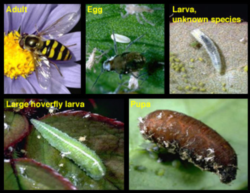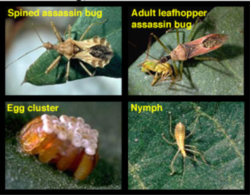Inviting the good guys into your garden
-
Pirates, assassins and soldiers, oh my! If you’ve got these adorning your flowers, vegetables and trees, how fortunate you are—if they’re bugs that is. You’ve got good bugs—ones that you want to protect and encourage to take out bad bugs that may be lurking around. Don’t believe the outdated adage that “the only good bug is a dead bug.” For every bad bug out there, there are plenty of good ones—many working 24/7 to help control pests that assault your garden. Before you whip out the spray to wipe them out, know who you’re dealing with – and why it makes all the sense in the world to preserve and encourage the garden good guys.
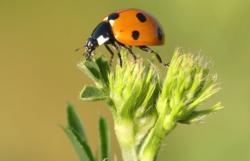 Both the adults and the larvae of lady beetles chow down on aphids. Photo: Sue Thomas, Unsplash
Both the adults and the larvae of lady beetles chow down on aphids. Photo: Sue Thomas, Unsplash
The world is filled with insects—there are more than a million named species of them. Yet it’s estimated that only about one percent are truly harmful. Most insects go about their daily business pollinating plants, helping to decompose dead material, being meals for birds, fish and other creatures. One big service they provide that is hidden from most of us is keeping pest populations down. Again, it’s the good bugs battling the bad ones.What’s in a beneficial name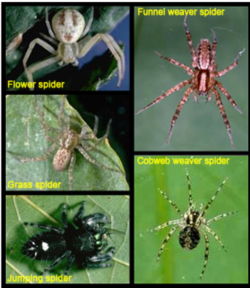 Spiders are predators who consume insects &even other spiders. Some snag prey in webs; others stalk their prey by pouncing on them. Photo: UC Regents
Spiders are predators who consume insects &even other spiders. Some snag prey in webs; others stalk their prey by pouncing on them. Photo: UC Regents
Garden good guys go by many names: beneficial insects, bio-control agents, natural enemies, biological pest control, and beneficials. They are garden helpers: predators, parasites or disease producing organisms that help control damaging pests by killing them, decreasing their ability to reproduce, or reducing their numbers. While the majority of beneficials are insects, there are also spiders and mites (arachnids), nematodes, and a wide range of microbes. The most effective natural enemies are relatively host specific – that is, they go after a single pest species or a group of similar pests. For instance, the well-loved lady bugs (Coccinellidae) are generally associated with feeding on aphids; however, other species within the group prefer to dine on scale, mealybugs, whiteflies, or mites. Great news for gardeners! Some less familiar but equally voracious beneficials are assassin bugs (Reduviidae), minute pirate bugs (Anthocoridae), soldier beetles (Cantharidae) and syrphid flies (Syrphidae).
How to invite good guys into your gardenEncouraging beneficials in your garden is about the greenest method of pest control you can use. “Bug-on-bug” warfare is the way things exist in nature, and while it may not provide you with a pest free environment, if you give them time to do their magic, you can reach a level of tolerable damage without the use of any type of chemical control. It’s easy to do.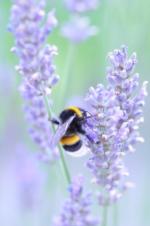 Like people and other mammals, insects need food, water, and shelter. Photo: Thomas Jörn, Unsplash
Like people and other mammals, insects need food, water, and shelter. Photo: Thomas Jörn, Unsplash• Provide the habitat they need - Like any living creature, the good guys need food, water, and shelter, all generally available in the garden.
• Plant a wide variety of flowering plants - Diversity in plants encourages a range of beneficials; sequentially flowering species provide natural enemies with nectar, pollen, and shelter throughout the growing season. Some favorites include members of the carrot family (Apiaceae), dill, fennel and parsley; the daisy family (Asteraceae), coneflowers, daisies and yarrow; and herbs like rosemary and thyme. Tolerating low populations of plant-feeding insects and mites ensures that food is available to the hungry garden helpers.
• Reduce dust - Dust can interfere with natural enemies and result in outbreaks of pests such as spider mites.
• Don’t overdo fertilization and irrigation - Lots of lush new growth on plants actually encourages sucking pests like aphids to reproduce more rapidly than natural enemies can control.
• Avoid pesticides - Don’t be too quick to whip out the insect spray. Broad-spectrum pesticides often kill a higher proportion of garden good guys than the pests they’re attempting to control. Many are killed right away (contact toxicity) and any pesticide residue can also kill natural enemies that migrate in after spraying (residual toxicity). If they do survive, the pesticide residues can interfere with the beneficial insects’ reproduction and their ability to locate and kill pests. And be careful when using combined products—ones that both feed the plant and control pests. Most of these function as systemic insecticides, circulating toxic chemicals throughout the plant, so anything that feeds directly (an aphid feeding on a rose), or indirectly (the ladybug eating the aphid) on it can be affected.
How do you tell which bug is good and which isn’t? Steven Swain, UCCE Environmental Horticulture Advisor suggests, “Telling the good bugs from the bad ones can be difficult, especially at first. Syrphid fly larvae (beneficials) look a lot like green caterpillars (not beneficials), and spined soldier beetles (good guys) look pretty similar to some lygus bugs (generally bad guys). Since it doesn’t do a lot of good to learn about beneficial insects that you never see, perhaps one of the best ways to get familiar with them is to start with what is in your garden. Get a small, sealable glass jar, find one or two, catch them (gently), and identify them—there are a lot of resources out there to help you.”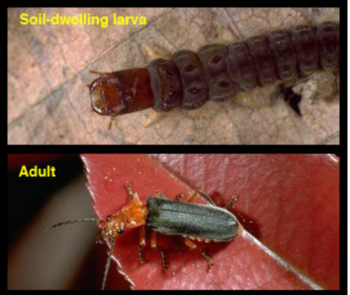 Soldier beetles feed under bark or in soil or litter, where they gobble up eggs and larvae of less desirable insects. Photo: UC Regents
Soldier beetles feed under bark or in soil or litter, where they gobble up eggs and larvae of less desirable insects. Photo: UC RegentsTo get you started, here are some common garden good guys for you to identify in your garden. Other resources include your local library, the Sunset Western Garden Book, and the UC Marin Master Gardener Help Desk,
at 1682 Novato Blvd., Suite 150B, in Novato (415-499-4204 or HelpDesk@MarinMG.org).
According to Swain, “Once you’ve identified what is in your garden, you can learn about their life cycle, what they like to eat, and the environments that best suit them, and keep these conditions in mind as you consider your next garden projects. The nice thing about this approach is that the more you learn to identify, the more things you start seeing in your garden, and it often makes the next identification even easier.”Original article by Nanette Londeree for the Marin IJ
Edited by Marie Narlock for the Leaflet





